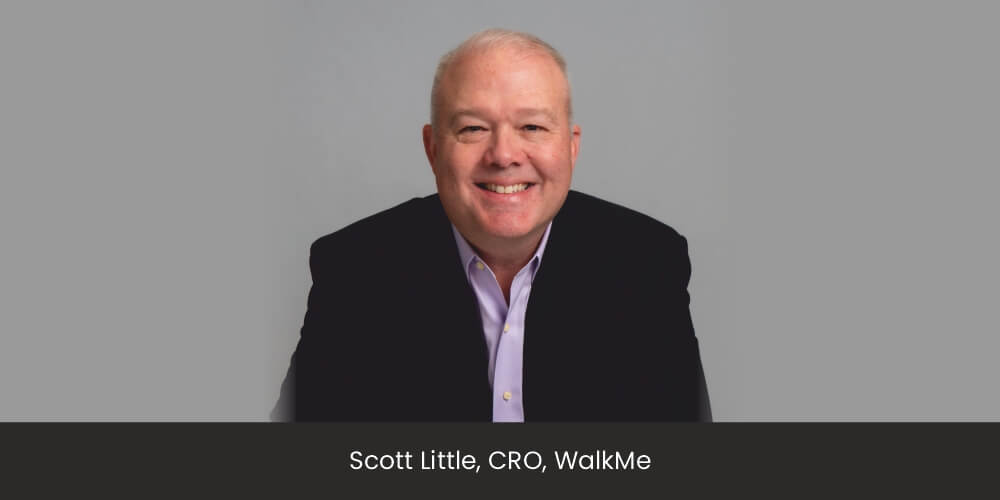Scott Little embarked on his career with a strong foundation in sales, having received exceptional training during his tenure at IBM as a young sales representative. Over the course of the next 19 years, he meticulously climbed the professional ladder, navigating through various sales positions until he assumed senior sales leadership roles at Oracle, a renowned technology corporation.
Seeking new challenges and experiences, Scott transitioned to smaller but equally impactful companies, including CommVault and AVEVA. These experiences enriched his skill set and industry knowledge.
Scott’s career trajectory reached new heights when he assumed the role of Chief Revenue Officer (CRO) at Software AG, a prominent German-based software company boasting a substantial $900 million in revenue. Currently, he holds the esteemed position of CRO at WalkMe.
As the Chief Revenue Officer, Scott is entrusted with the critical task of driving annual recurring revenue (ARR) to meet the company’s targets. His responsibilities encompass managing all aspects of customer relationships and revenue generation, which includes overseeing subscription services, software offerings, and professional services.
Below are highlights of the interview:
Tell us about WalkMe™ and its mission. What inspired you to join this company?
WalkMe helps companies realize the value they expect in their digital transformation projects with the new applications and processes that they deploy. We do this by removing digital friction, which is the extra effort employees have to exert to use technology. For example, when clients roll out new solutions—ERP, CRM, HCM, etc.—as part of their digital transformation project, WalkMe helps them get the most value out of this investment by lowering the bar for adoption.
I joined WalkMe because of the tremendous opportunities I saw (and still see) in the digital adoption space. WalkMe is the category creator and market leader, with amazing customers around the world. I really feel like we’re just scratching the surface and still have lots of runway to grow, which was very enticing to me as I like to build organizations and grow with them.
Could you elaborate on your involvement in aligning sales, marketing, and other revenue-related departments to achieve organizational goals?
I think it’s incredibly important that the CRO has a seat at the table with executive leadership, along with the CRO’s peers, the Chief Customer Officer and the Chief Marketing Officer. And between those three, we own the full life cycle of the customer: Marketing helps find an opportunity to help a client, sales sells to that client, and the customer success group (CSG) makes sure the client implementation is successful and the client is happy through the term of their subscription. CSG also helps the sales organization look for new opportunities to sell new capabilities to the client and/or expand their existing usage. So as part of that three-headed go-to-market organization, I can have a say in what marketing messages will land with clients. We also review the pipeline, pipeline performance, and the performance of our campaigns in the field on a weekly basis.
It’s difficult to ask a customer to expand if they are not happy. So my job on the other side of the process is to make sure that during the hand-off between my team and the professional services team, the client understands the value that we sold them and that what they bought was what they were expecting when they deployed.
What key trends and shifts do you see in the industry that are impacting revenue generation strategies?
Digital transformation has been an ongoing topic for more than a decade, and the organizational changes related to digital transformation have also been an ongoing topic for the same amount of time. As interesting as it was to serve the digital transformation market, we’re seeing the deployment and consumption of generative AI (GAI) technologies become the new “digital transformation” of today. As disruptive and opportunistic as GAI is, we think it’s going to be two orders of magnitude more disruptive. The time of opportunity implies all of the same challenges clients had when trying to deploy classic digital transformation, but we are in the best position to assist this transformation, just like with digital transformation. Risks are higher with GAI, and we can help with all of that adoption, expansion, compliance, and data security. In other words, rolling out GAI technologies across the enterprise implies all the same challenges clients had when going through digital transformation; they’re going to have the same issues with GAI. Companies are going to struggle, and we are in the best position.
With your extensive experience, what advice would you give to aspiring commercial executives looking to excel in the world of revenue growth?
Enterprise software sales is what I can speak to, and I can provide two pieces of advice:
1: You need to have some kind of framework and nomenclature to talk about your sales process so it’s in the same terms for everyone in the organization to understand. We have chosen value-selling here at WalkMe. I’ve used IBM large account selling, Sandler, Miller Heiman—there are tons out there, and they work roughly in the same way. Pick one.
2: Make decisions, not as often as you can, but as best you can—but not based on gut feelings. Use data; be as data-driven as possible. This is not just for your sales organization, but across the business. If the data isn’t clear, you need to rely on your experience, but the more data and analysis you have, the more successful you will be.
Could you highlight a memorable experience where your leadership played a pivotal role in achieving revenue objectives?
In one organization I came into, I needed to understand how long it took to close a deal. So I looked not only at the data but also any nuances around that data, i.e., was there anything geography-specific? Size specific? Etc. When you don’t have enough data, you tend to go with what people tell you. People were telling me that the typical sales cycle was 9–12 months. After looking at the data, I found the sales cycle was actually much shorter on average. It was about 5–6 months, with up-sale at 4-5 months. So, our average time to close a deal was not what the conventional wisdom thought. This changed the way we converted and how quickly we closed the pipeline. It changed so much about how we spent marketing money and sales attention. It had all been based on bad data. And once I figured this out, we made decisions based on the correct data.
Beyond your professional endeavors, what are some of your personal interests or hobbies that help you maintain a well-rounded and energized perspective?
I love sports. I grew up playing football, basketball, and golf, and I even met my wife when I was out playing a pick-up game of basketball when I was in college. I also enjoy skiing with my family. I have a long tradition with my daughters in which I take them on a ski trip each year. Staying “competitively active” helps me stay on top of my game.
Where do you see the future of revenue generation heading, and what strategies do you plan to adopt to stay ahead of the curve?
I see generative AI technologies becoming part and parcel of the way professional sales organizations communicate, support, and sell to their clients. For me, it’s figuring out how to best implement those technologies across my organization and within our sales process. It’s very new and very exciting.
Website: WalkMe™





